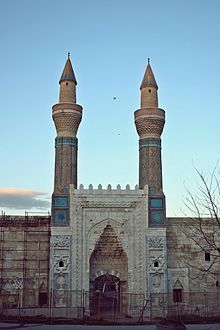Gökmedrese or Gök Medrese (literally: "Celestial Madrasah" or "Blue Madrasah"; Persian: گوک مدرسه), also known as Sahibiye Medresesi, is a 13th-century medrese, an Islamic educational institution, in Sivas, Turkey.
| Gökmedrese Sahibiye Medresesi | |
|---|---|
 | |
| Religion | |
| Affiliation | Islam |
| Location | |
| Location | Sivas, Turkey |
| Geographic coordinates | 39°44′39″N 37°01′00″E / 39.74424°N 37.01666°E |
| Architecture | |
| Architect(s) | Kaloyan[1] |
| Type | Madrasah |
| Style | Seljuk |
| Completed | 1271 |
| Specifications | |
| Direction of façade | west-southwest |
| Width | 31.25 m (102.5 ft) |
| Minaret(s) | 2 |
| Minaret height | 25 m (82 ft) |
| Website | |
| www | |
History
editThe medrese was commissioned by Sahip Ata Fahrettin Ali, a vizier and the de facto ruler of Seljuk Sultanate of Rûm after the death of Pervane in 1277. Up to 1271, he was usually in good terms with Pervane. He commissioned many buildings in Anatolia. Gökmedrese is one of the most imposing of all. The original name of the medrese is Sahibiye, referring to Sahip Ata. But it is usually known as Gökmedrese, because of the sky-blue tiles used at the building.
The medrese was constructed by an architect[a] known as "Kaloyan" (Byzantine Greek: Καλό Γιάννη, "Kalo Yianni," literally 'good John') from Konya.[1] Originally, it was a two-story building. There were also a hamam (Turkish bath) and a soup kitchen for 30 people. But presently, only the 13 rooms of the lower floor exist. It was restored in 1823 and was in use up until 1926.[2]
Technical details
editThere are two 25 m (82 ft) high minarets, one at each side of the portal. The width of the building is 31.25 m (102.5 ft). The dimensions of the courtyard is 24.25 m × 14.40 m (79.6 ft × 47.2 ft). There are two divisions, one leading to the mescit (prayer room) and the other to class rooms.[2]
Vakıf
editIn middle age Islamic countries Vakıf was a source of revenue, endowed for the exploitation and the maintenance of the foundations as well as for the salaries of the staff. In Gökmedrese case, there were 85 markets, nine villages, two farms and some other sources endowed as vakfiye.
Gallery
edit-
Muqarnas on the portal.
-
Gök Medrese during restoration shot from right side
-
Gök Medrese before restoration Portal from left side
-
Gök Medrese before restoration Decoration corner
-
Gök Medrese before restoration Ceiling inside
-
Gök Medrese during restoration Minarets
-
Gök Medrese before restoration Portal
-
Gök Medrese before restoration Portal detail
-
Gök Medrese before restoration Portal detail
-
Gök Medrese before restoration Portal detail closer up
-
Gök Medrese before restoration Portal side
-
Gök Medrese before restoration Decoration
-
Gök Medrese before restoration shot from side
Notes
edit^ a: possibly of Armenian[3][4][5] or Cappadocian Greek origin[6]
References
edit- ^ a b "Arcnet". Archived from the original on 2012-11-30. Retrieved 2013-06-19.
- ^ a b http://eskidergi.cumhuriyet.edu.tr/makale/1290.pdf Archived 2019-07-13 at the Wayback Machine (in Turkish)
- ^ А. Л. Якобсон [in Russian] (1983). "Сельджукские отклики на темы армянский средневековой архитектуры" (PDF). № 4 . стр-цы. 126-130. ISSN 0135-0536. Историко-филологический журнал. Archived from the original (PDF) on 2013-10-04. Retrieved 2012-11-17.
- ^ Maxim Yevadian: Les Seldjouks et les architectes arméniens, Les Nouvelles d'Arménie Magazine, Nr. 156, October 2009, p. 73.
- ^ Ars Islamica / Detroit Institute of Arts. Research Seminary in Islamic Art / University of Michigan Press, 1939 - p. 67
La signature Kaloyan du Gok Medrese de Sivâs (1270) est également arménienne
- ^ Speros Vryonis (1981). Studies on Byzantium, Seljuks, and Ottomans. p. 282.
Perhaps the best known of these architects was the Greek from Konya, Kaloyan, who worked on the Ilgin Han in 1267-8 and three years later built the Gök Medrese of Sivas.